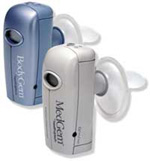Measuring VO2 With A Microlife MedGem And BodyGem
The Microlife BodyGem and MedGem indirect calorimeters measure Resting Metabolic Rate, to help your clients reach their weight loss goals.
 Instead of estimating RMR with the Harris-Benedict or Katch-McArdle formula, the BodyGem and MedGem scientifically measure a clients VO2 to determine their Resting Metabolic Rate (RMR).
Instead of estimating RMR with the Harris-Benedict or Katch-McArdle formula, the BodyGem and MedGem scientifically measure a clients VO2 to determine their Resting Metabolic Rate (RMR).
Estimation formulas cannot factor in thyroid issues, the effects of medications, etc.
Why is it necessary to measure oxygen consumption?
Most healthcare professionals recognize that resting metabolic rate is impacted by unique characteristics such as age, obesity, body composition (muscle versus fat), recent weight changes, disease state, surgery, fever, stress, and medications.
When assessing a patient’s nutritional needs, knowledge of RMR is critically important for determining the patient’s unique nutritional needs.
In the clinical setting, a patient’s resting metabolic rate may increase or decrease significantly depending on the patient’s status. For example, when a patient develops a fever, RMR may increase significantly.
Monitoring these changes will allow the healthcare professional to revise nutrition recommendations to meet the patient’s changing needs. In some instances, this will mean measuring RMR daily.
In outpatient settings, it is appropriate to re-measure every ± 10% weight change to ensure continued weight management success.
Factors Influencing Oxygen Consumption and RMR
- Body weight: A larger person will typically have a higher oxygen consumption because the body must provide energy to support the extra body mass.
- Body composition: Muscle requires more oxygen than fat, even at rest. People with a higherpercentage of muscle will usually have a higher RMR. Exercise, especially resistance training, can increase lean tissue, and therefore increase RMR.
- Age: RMR declines naturally in adults at a rate of about 3% per decade after age 30. However, this decrease is primarily a result of muscle loss.
- Gender: Men normally have a higher oxygen consumption than women, partly because they tend to have a lower percent body fat than women,
- Hormones: Certain hormones can increase or decrease oxygen consumption. The thyroid gland has the most marked effect on metabolism.
- Stress: Stress, trauma, burns, infections, and sepsis promote a hypermetabolic response. The severity of the surgical procedure or the trauma influences the metabolic response.
- Medications: Medications can increase or decrease oxygen consumption depending on the mechanism of action.
- Genetics: There are many genetic factors that may increase or decrease resting metabolic rate.
For the best care, the American Dietetics Association recommends using indirect calorimetry to measure RMR for the most accurate assessment of nutritional needs.
Health & Fitness Network is an authorized distributor of the BodyGem© and MedGem© RMR devices by Microlife Medical Home Solutions.
The BodyGem and MedGem have the same functionality, accuracy and reliability. The difference is that the MedGem has gone through the FDA-approval process, to allow licensed clinicians to make insurance claims on their measurements.
These indirect calorimeters measure your clients Resting Metabolic Rate in 5-10 minutes, to provide them with a scientifically based Daily Calorie Budget, to help them reach their weight goals.
Click on the links for more information on the Microlife BodyGem or MedGem indirect calorimeters
Contact me at 1-800-743-3328 to discuss Microlife BodyGem RMR System Kit pricing options.
Harvey Harris